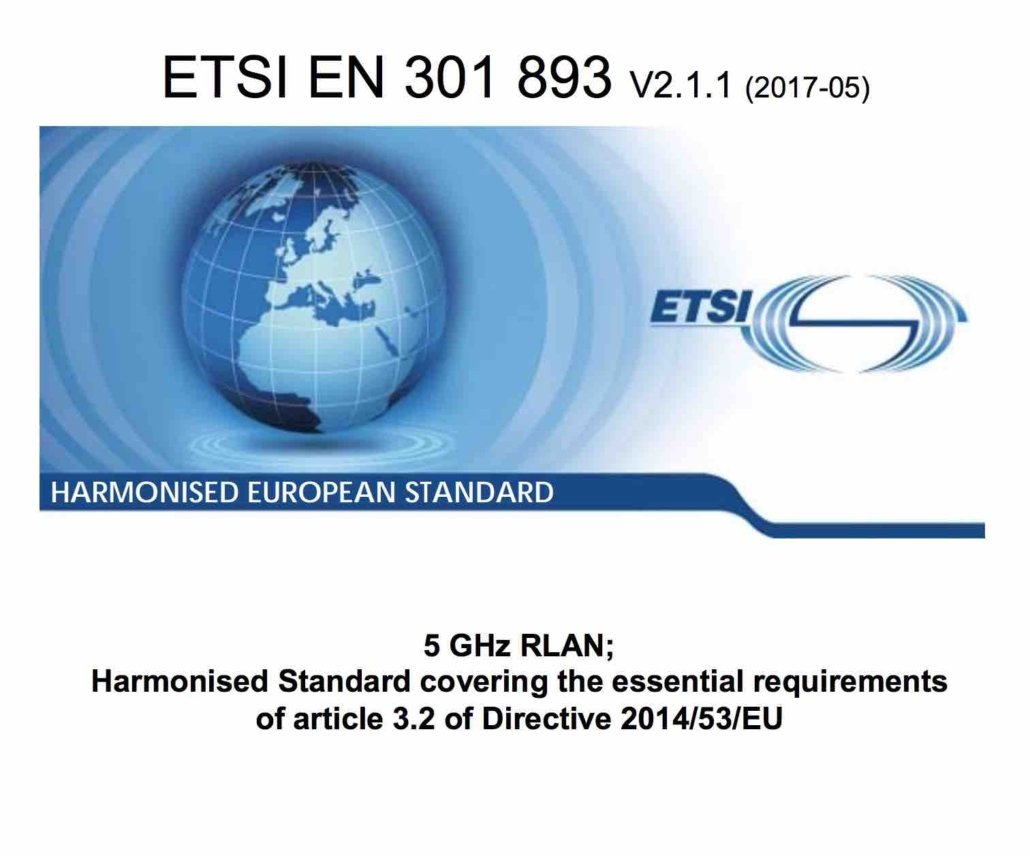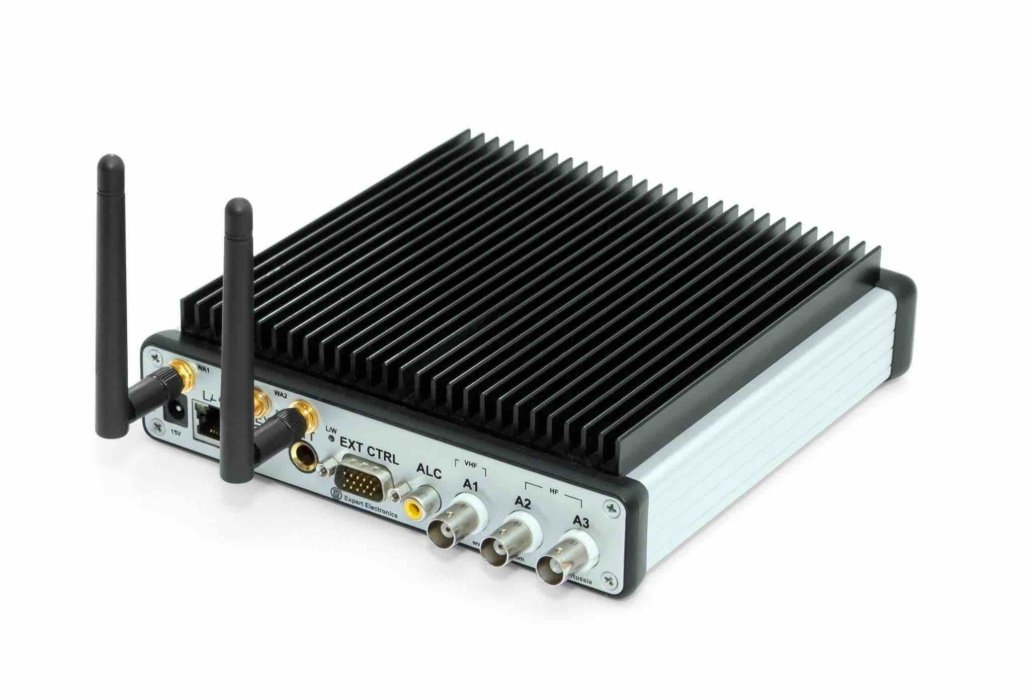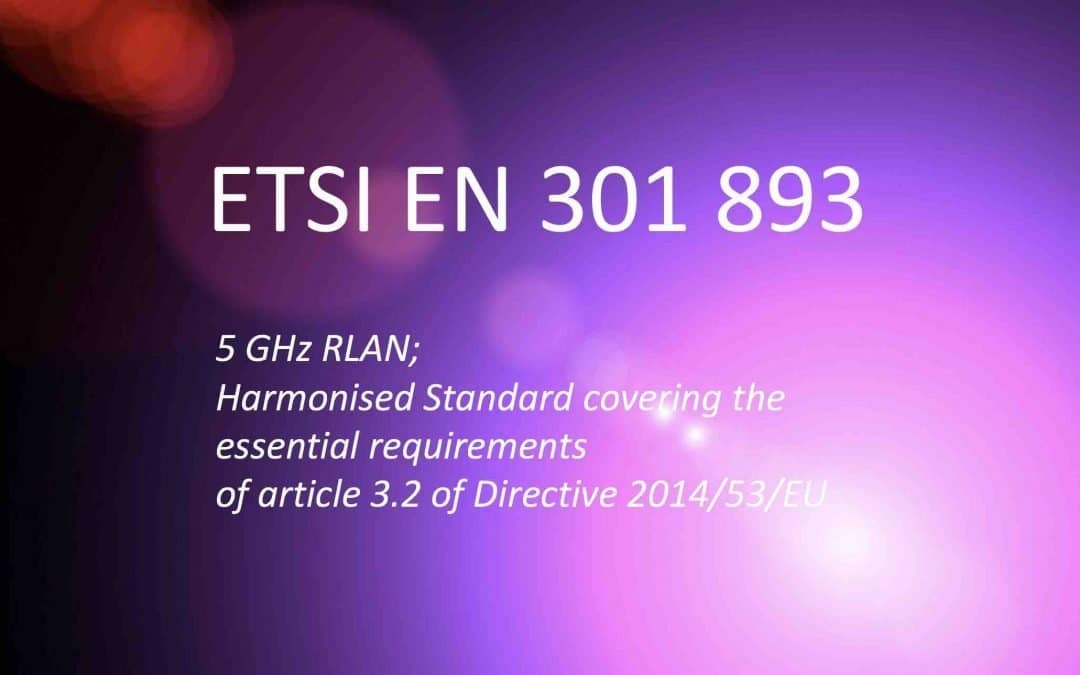In this post, we will inform you about ETSI EN 301 893 standard which is published by ETSI and used for CE marking of Radio Local Area Networks (RLANs). This harmonised European standard is titled as follows:
5 GHz RLAN;
Harmonised Standard covering the essential requirements
of article 3.2 of Directive 2014/53/EU
Since ETSI standards are free of charge, you can download the latest version of ETSI EN 301 893 from ETSI web page or click on below image:

Click here to see ETSI EN 301 893 V2.1.1 (2017-05)
This standard specifies technical characteristics and methods of measurements for 5 GHz wireless access systems (WAS) including RLAN equipment. It also describes spectrum access requirements to facilitate spectrum sharing with other equipment. These radio equipment are capable of operating in all or parts of the frequency bands given below:
| Transmit (Tx) | 5 150 MHz to 5 350 MHz |
| Receive (Rx) | 5 150 MHz to 5 350 MHz |
| Transmit (Tx) | 5 470 MHz to 5 725 MHz |
| Receive (Rx) | 5 470 MHz to 5 725 MHz |
Definitions
In order to understand standards better, definitions are so essential. Some of the definitions given in ETSI EN 301 893 lists are shown below:
RLAN devices: 5 GHz wireless access systems (WAS) including RLAN equipment
5 GHz RLAN bands: total frequency range that consists of the 5 150 MHz to 5 350 MHz and the 5470 MHz to 5 725 MHz sub-bands
master mode: mode which relates to the DFS functionality where the RLAN device uses a Radar Interference Detection function and controls the transmissions of RLAN devices operating in slave mode
multi-radio equipment: combined equipment consisting of two or more radio products (transmitters, receivers or transceivers) or a single radio product operating in two or more bands simultaneously

Which tests are applied?
Applicable tests depend of the features of the product. Technical requirements specifications of the standard defines the type of tests or parameters that shall be checked:
Nominal Centre frequencies
Nominal Channel Bandwidth and Occupied Channel Bandwidth
RF output power, Transmit Power Control (TPC) and Power Density
Transmitter unwanted emissions
Receiver spurious emissions
Dynamic Frequency Selection (DFS)
Adaptivity (Channel Access Mechanism)
Receiver Blocking
User Access Restrictions
Geo-location capability
The purpose and applicability of each test item or parameter is given on the standard. For instance, Receiver Blocking is a measure of the capability of the equipment to receive a wanted signal on its operating channel without exceeding a given degradation due to the presence of an unwanted input signal (blocking signal) on frequencies other than those of the operating bands provided in table 1.
In which conditions test are performed?
There are two conditions specified in the standard:
- Normal test conditions
- temperature: +15 °C to +35 °C
- relative humidity: 20 % to 75 %
2. Extreme test conditions
Some tests in the present document need to be repeated at extreme temperatures. Where that is the case, measurements shall be made over the extremes of the operating temperature range as declared by the manufacturer.
Before starting the tests
Standard asks some features from the manufacturer. Prepare the answers of below questions, before starting the tests:
- Operating Frequency Range(s):
Range 1: 5 150 MHz to 5 350 MHz and 5 470 MHz to 5 725 MHz
Range 2: 5 470 MHz to 5 725 MHz
Range 3: 5 150 MHz to 5 250 MHz (ad-hoc without DFS)
Range 4: other, please specify: ……………..
If the equipment has more than one Operating Frequency Range, tick all that apply.
- Can the transmitter operate un-modulated?
- The transmitter is intended for : a) Continuous duty b)Intermittent duty, c) Continuous operation possible for testing purposes
- Adaptivity (Channel Access Mechanism): a) Frame Based Equipment b) Load Based Equipment
- The equipment supports a geo-location capability: a) Yes b) No
Do you have RLAN to be tested?
Do you want to have testing service according to ETSI EN 301 893 standard?
Contact Testups, get your quote, send test sample to us, get your testing and reporting service.

Recent Comments